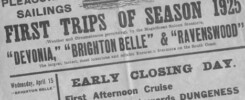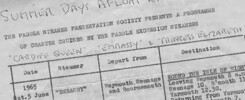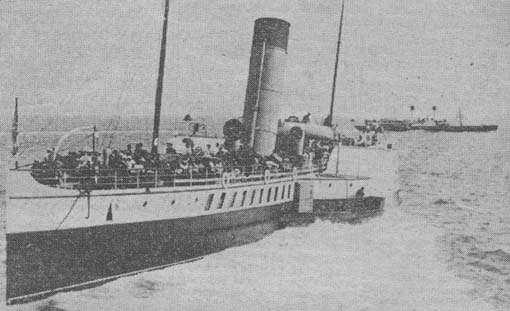
One hundred and ten years ago, in the summer of 1895, a large, new paddle steamer appeared on the South Coast of England. With a flush deck extending almost the whole length of the ship, she was a real step forward in excursion paddle steamer design outclassing anything seen in the area before. Sadly, though, few intended services have had “non-starter” written on them quite so plainly as the programme put together for the first season of the Plymouth Belle (pictured above with the Alexandra of 1863 astern of her).
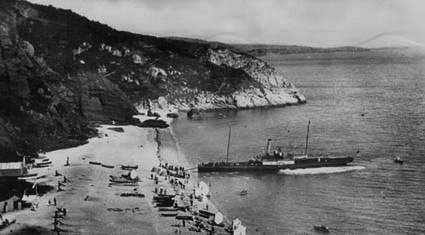
Just how big a step forward in paddle steamer design she was can be seen by comparing her with her contemporaries. The Duchess of Devonshire was built only three years earlier with mostly open decks for service on the Devon coast.
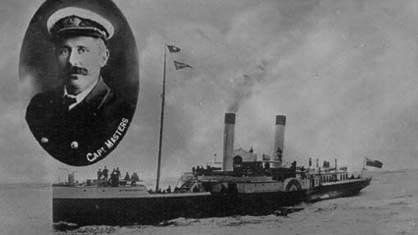
The Monarch (right) was built only seven years earlier for long distance South Coast and Cross Channel work. She had nearly another fifty years of service ahead of her at that time but even then had an air of the antique about her in comparison with the sleek, modern and luxurious Plymouth Belle.
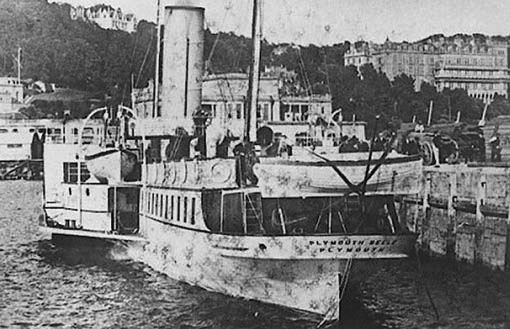
Plymouth Belle was commissioned by the Plymouth Belle Steamship Company whose principal was Mr William Dusting of Saltash. Based at Plymouth she was programmed to run long coastal excursions extending as far west as the Scilly Isles and, in July and August, to run three day weekend excursions to the Channel Islands. These started at Penzance and called at Falmouth, Dartmouth and Torquay en route to Guernsey and Jersey from which Plymouth Belle sometimes added a return trip to St Malo.
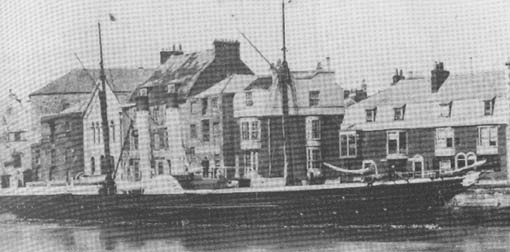
As Plymouth men, Mr Dusting and his associates would have known that the ex Weymouth cross channel ferry Aquila (pictured above at Weymouth) had been providing a service from Plymouth to the Channel Islands in private ownership since 1889 and was to be withdrawn in 1894 leaving a gap in the market. On paper, therefore, the idea of a fast, modern excursion steamer offering unrivalled views of the magnificent South Devon and Cornish coastal scenery coupled with a Cross Channel ferry operation linking the west country directly with the Channel Islands saving people from having to make the long haul by road or rail to Weymouth to catch the regular ferry, might, all in all, have seemed an unstoppable winner in any business plan.
In practice, however, the business plan proved deeply flawed. Doubtless there were people for whom such long coastal cruises would have been an attraction but, as it turned out, there were not many. Doubtless there were people who would have benefited from a direct link from the West Country to the Channel Islands but there were not many of those. And doubtless there were people who would have enjoyed a three day excursion to the Channel Islands. But there were not many of them either.
There are few large population centres along that coast from which locals could be drawn in significant numbers. Perhaps there never were enough sufficiently well off tourists visiting Penzance, Falmouth, Plymouth and Torquay to make a go of such an expensive service and long excursions in this part of the UK have never proved very popular despite the stunning scenery . Even those masters at exploiting commercial opportunities like P & A Campbell never really succeeded in their various attempts over the years to base a big ship at Torquay and Plymouth. A three day sojourn across the Channel might also have been a nice thing to do if you had money but it would automatically have excluded ordinary holiday makers who would already be paying for hotel accommodation in the resort of their holiday. Plymouth Belle’s first season was not a success and she spent only the peak weeks of 1895 running on the ambitious service for which she was designed and built.
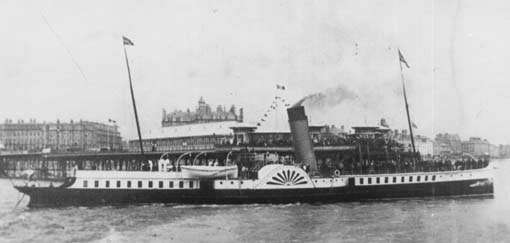
For the following two years Plymouth Belle was chartered to Capt Collard of Eastbourne for his routes on the Sussex coast. These included cross channel trips to Boulogne on which she provided a level of comfort way above any of her competitors, which, coincidentally, included the veteran Aquila now sporting only one funnel and running in yet another career extension now masquerading under the name of Ruby. Things did not always run smoothly on the Sussex Coast either. Weather was always a problem with the exposed piers and sometimes, whilst the wind might have been fine for a call in the morning, it might well have deteriorated during the day sending later arrivals and departures into chaos as passengers waited on piers for paddlers which could not get in or found themselves on paddlers they could not get off, or at least not get off where they wanted to get off, as the ships ran for shelter.
A report in a local paper tells that on Sunday July 25 1897, Plymouth Belle reached Boulogne at 3.45pm on a normal trip and started back at 6pm:
The weather cut up rough so she had to go straight to Newhaven after Eastbourne which she reached at 1am on Monday. Meanwhile the Brighton excursionists who had landed at Eastbourne in the morning for a day were in a bit of a dilemma. The Plymouth Belle had dropped 120 at Eastbourne; when it was realised that the ship was not going to pick them up to take them back due to the weather, fifty refused to take the train at their own expense and twenty of them had no money left anyway. The Piermaster, Mr George Sawdle put them up in the old Pavilion and on the Monday morning, with one of their number, Mr John Pratt, as spokesman, they waited at the Magistrate’s Court until after the last case and demanded their fares back to Brighton. The money was produced and the clerk got in touch later with Capt Collard.
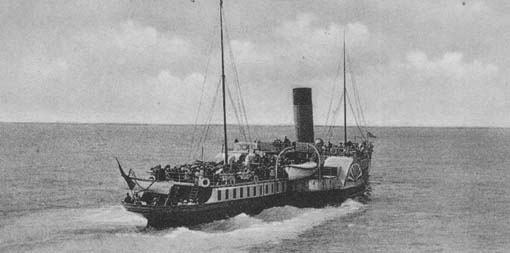
For 1898 Plymouth Belle continued to appear on the Sussex Coast now under charter to South Coast and Continental Steamers Ltd of Southampton, a company name which would be revived sixty five years later to buy the Consul for another ill-starred venture. Plymouth Belle brought a transformation to paddle steamer design on the South Coast. She started her career in a spirit of optimism. But in the end she ran for only four seasons in the UK. In 1899 she was sold to Germany where she had a much more successful career operating on the Hamburg-Amerika Packetfahrt route between Hamburg and Heligoland as the Willkommen until the 1920s when she was withdrawn and scrapped.
Geoff Hamer emailed on 8th August 2005 to say:
As usual, I looked at your monthly page with interest. The PLYMOUTH BELLE is mentioned in several books, but few have pictures of her. I think she may have been the first steamer on the South Coast with a “Belle” name. Sussex later had WORTHING, SUSSEX and BRIGHTON BELLEs. At Plymouth, the Millbrook Steamboat Co later had a fleet of BELLEs, of which the PLYMOUTH BELLE (1960) and NORTHERN BELLE (1929) still run there, along with DEVON and TAMAR BELLEs.
I have some German books which give the later history of the PLYMOUTH BELLE. Under Hapag, the WILLKOMMEN was used both on the Hamburg-Cuxhaven-Helgoland-Sylt service and as a tender. The island of Sylt was later joined to the mainland by a causeway, but the only other connection to the mainland then was by steamers whose schedules depended on tides. Hapag sold her in October 1924 to Hamburg-Stade-Altländer Linie who renamed her CUXHAVEN. She became their flagship and was used for excursions on the Lower Elbe. In March 1929, they were taken over by HADAG who did not use the CUXHAVEN. She was sold for scrap in October 1929 and, interestingly, the breakers were apparently British, though I don’t know the location.
Kingswear Castle returned to service in 2023 after the first part of a major rebuild which is designed to set her up for the next 25 years running on the River Dart. The Paddle Steamer Kingswear Castle Trust is now fund raising for the second phase of the rebuild. You can read more about the rebuilds and how you can help if you can here.
John Megoran

